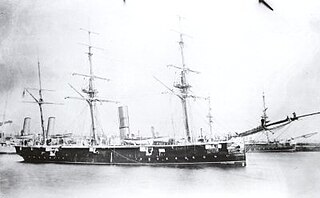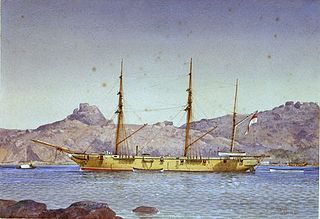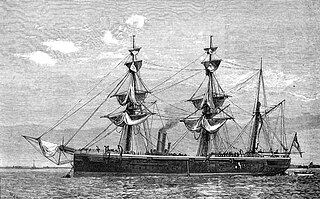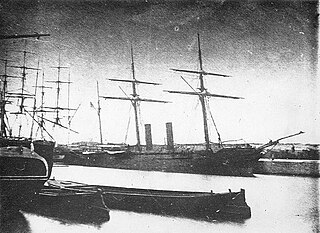Related Research Articles

Steam frigates, also known as screw frigates, the larger screw ship of the lines and the smaller steam corvettes, steam sloops, steam gunboats and steam schooners, were steam-powered warships that were not meant to stand in the line of battle. The first such ships were paddle steamers. Later on the invention of screw propulsion enabled construction of steam-powered versions of the traditional frigates, corvettes, and sloops.

The Osprey class was a Royal Navy class of screw-driven sloops built between 1874 and 1877. Nine additional ships were built to a revised design, the Doterel-class sloop. They were the first class of ship in the Royal Navy to use glass scuttles.

HMS Hornet was a 17-gun wooden screw sloop of the Cruizer class of the Royal Navy, launched in 1854 and broken up in 1868.

HMS Colossus was a 80-gun second rate Vanguard-class ship of the line built for the Royal Navy in the 1840s. The ship was fitted with steam propulsion in 1854–1855, and was sold for scrap in 1867.

The Mariner class was a class of six 8-gun gunvessels built for the Royal Navy between 1883 and 1888. Four were built in the Naval Dockard at Devonport, and two elsewhere; the Acorn was built by contract at Jacobs Pill on the Pembroke River, while the Melita was built in the Malta Dockyard, the only substantial ship of the Royal Navy ever to be built in the island.

The Arrow class comprised six second-class screw-driven vessels built as despatch vessels for the Royal Navy in 1854, mounting 6 guns. In 1856 they were redesignated as second-class gunvessels.

The Satellite class was a class of 12-gun composite sloops built for the Royal Navy between 1883 and 1888, and reclassified as corvettes in 1884.

HMS Cordelia was an 11-gun Racer-class sloop of the Royal Navy launched in 1856 and sold in 1870.

The Doterel class was a Royal Navy class of screw-driven sloops. They were of composite construction, with wooden hulls over an iron frame. They were a revised version of an 1874 design by the Royal Navy's Chief Constructor, William Henry White, the Osprey-class sloop. Two of the class were lost, one to an explosion off Chile and one wrecked off Canada. Gannet is preserved at Chatham Historic Dockyard.

HMS Phoenix was a 6-gun steam paddle vessel of the Royal Navy, built in a dry dock at Chatham in 1832. She was reclassified as a second-class paddle sloop before being rebuilt as a 10-gun screw sloop in 1844–45. She was fitted as an Arctic storeship in 1851 and sold for breaking in 1864.

The Racer-class sloop was an 11-gun wooden screw sloop class of five ships built for the Royal Navy between 1855 and 1860.

HMS Basilisk was a first-class paddle sloop of the Royal Navy, built at the Woolwich Dockyard and launched on 22 August 1848.

HMS Miranda was a Doterel-class sloop of the Royal Navy, built at Devonport Dockyard and launched on 30 September 1879.

HMS Espiegle was a Doterel-class sloop of the Royal Navy, built at the Devonport Dockyard and launched on 3 August 1880.

Intrepid-class gunvessels were a class of six Royal Navy first-class wooden gunvessels built in 1855-56. They were rated as sloops from 1859 to 1862, and were scrapped by 1865. Victor was sold to the Confederate States of America as the raider CSS Rappahannock, but she was interned by the French at Calais and never fulfilled her intended function.

HMS Mutine was a Doterel-class sloop of the Royal Navy, built at the Devonport Dockyard and launched on 20 July 1880. She became a boom defence vessel at Southampton in 1899 and was renamed Azov in 1904. She was sold after World War I.

HMS Dragon was a Doterel-class sloop of the Royal Navy, built at Devonport Dockyard and launched on 30 May 1878. She served in the East Indies, including the Anglo-Egyptian War of 1882, and the suppression of slavery. She was sold for breaking in 1892.
The Highflyer-class corvettes were a pair of 21-gun wooden screw corvettes built in the 1850s for the Royal Navy.

The Cormorant-class gunvessels were a class of 4-gun first-class gunvessels built for the Royal Navy in the 1860s. They were somewhat unsuccessful; intended for shore bombardment in shallow water, they exceeded their design draft by 50%. Seven of the 13 ships ordered were suspended, with 3 finished or converted as survey ships and the other 4 cancelled. Racehorse was wrecked after only 4 years, and those ships that were completed as planned had short operational lives, in some cases less than 10 years. The survey vessels lasted longest, with the last ship of the class, Sylvia, being broken up in 1890.

The Conflict-class sloop was a class of two first-class wooden screw sloops built for the Royal Navy in the mid 1840s. Two other ships were ordered but cancelled shortly afterwards. Both completed ships served in the Baltic during the Crimean war, and Desperate briefly served as a store ship to Edward Augustus Inglefield's Arctic expedition. They had both been broken up by 1865.
References
- Winfield, R.; Lyon, D. (2004). The Sail and Steam Navy List: All the Ships of the Royal Navy 1815–1889 . London: Chatham Publishing. ISBN 978-1-86176-032-6.